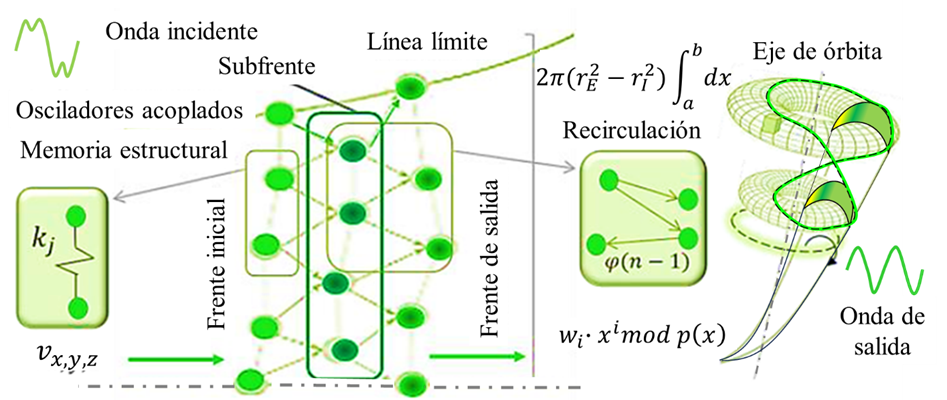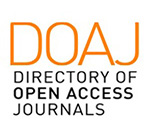xyz Modelo de Otimização de Arranjos de Generador Eólico para Captação de Energia Sustentável
Resumo
Esta pesquisa propõe uma atualização do modelo de captação de energia eólica, uma vez que atualmente não é considerada a compensação pelos efeitos ambientais, sendo necessária a configuração de um arranjo inteligente de pipas eólicas. O objetivo foi definir um termo de feedback de fluxo difratado, analisando sua contribuição para a otimização da eficiência. O método baseou-se na correspondência entre um operador matemático e os elementos físicos do sistema. O conceito de filtro adaptativo com arquitetura LFSR (Linear Feedback Shift Register) configurável foi interpretado para o processamento de blocos de energia discretos em um combinador linear de fluxo de vento xyz, através de coletores flexíveis e realimentação de fluxo modulado. Como resultados dos testes do modelo em VHDL (Very High Speed Integrates Circuit Hardware Description Language), foram obtidos os coeficientes ótimos para a convergência do sinal de saída, em relação à referência. Entre as principais contribuições estão a simplificação por etapas, reportando uma melhoria na eficiência de 11,08%; o que nos permite concluir que o termo adaptativo proposto representa uma ferramenta para avançar no conceito de sistemas configuráveis baseados em modelos, para o desenvolvimento de novas tecnologias, máxima eficiência, mínimo custo energético e mínimo impacto ambiental
Downloads
Referências
BBC. (2023). El asombroso fenómeno que nos hace ver colores que no existen [en línea] disponible en: https://www.bbc.com/mundo/articles/ckre2gnvpkzo [consulta: 12 octubre 2023].
Benyus, J. (1997). Biomimicry: innovation inspired by nature. New York: William Morrow.
Bird, B., Stewart, W. E., Lightfoot, E. N., Klingenberg, D. J. (2013). Introductory transport phenomena. New York: Wiley.
Cardesa, J. I., Vela-Martín, A., Jiménez, J. (2017). The turbulent cascade in five dimensions. Science, 357(6353), 782-784.
Castelino, R., Kashyap, Y., Kosmopoulos, P. (2022). Airborne kite tether force estimation and experimental validation using analytical and machine learning models for coastal regions. Remote Sensing, 14(23), 6111.
Castellanos, J., Sandoval, C., Azpúrua, M. (2014). Implementación sobre FPGA de un Algoritmo LMS para un arreglo de antenas inteligentes. Revista Técnica de la Facultad de Ingeniería Universidad del Zulia, 37(3), 270-278.
Chowdhury, N., Shakib, M. A., , Xu, F., Salehin, S., Islam, M. R., Bhuiyan, A. (2022). Adverse environmental impacts of wind farm installations and alternative research pathways to their mitigation. Cleaner Engineering and Technology, 7, 100415.
Dief, T., Fechner, U., Schmehl, R., Yoshida, S., Rusdi, M. (2020). Adaptive flight path control of airborne wind energy systems. Energies, 13(3), 667.
French, A. P. (1974). Vibraciones y ondas. Curso de Física del M.I.T. Primera edición. Barcelona: Editorial Reverté.
González, L. G., Figueres, E., Garcerá, G., Carranza, O. (2016). Diseño de un emulador para sistemas de conversión de energía eólica. Revista Técnica de la Facultad de Ingeniería Universidad del Zulia, 38(2), 159-168.
González, A., Hinojosa, J. (2019). Study of the influence of protuberances in the trailing edge of airfoils and determination of their aerodynamic efficiency through CFD using Ansys Fluent. Revista Internacional de Métodos Numéricos para Cálculo y Diseño en Ingeniería, 35(3), 1-6.
Grant, R., Ghannam, T., Kennedy, A. (2021). A novel geometric model of natural spirals based on right triangle polygonal modular formations [on line] disponible en: https://arxiv.org/abs/2111.02895 [consulta: 12 octubre 2023].
Hagen, L., Petrick, K., Wilhelm, S., Schmehl, R. (2023). Life-cycle assessment of a multi-megawatt airborne wind energy system. Energies, 16(4), 1750.
Howland, M., Quesada, J., Martínez, J. (2022). Collective wind farm operation based on a predictive model increases utilityscale energy production. Nature Energy, 7, 818-827
Hu, Y., Huang, Z., Cao, Y., Sun, Q. (2021). Kinetic insights into thrust generation and electron transport in a magnetic nozzle. Plasma Sources Science and Technology, 30(7), 075006.
Lara, M., Garrido, J., Ruz, M. L., Vázquez, F. (2021). Adaptive pitch controller of a large-scale wind turbine using multiobjective optimization. Applied Sciences, 11(6), 2844.
Lehn, J., Benyus, J. (2012). Bioinspiración y biomimética en química: naturaleza de ingeniería inversa. New York: John Wiley & Sons.
Lellis, M., Mendonga, A., Saraiva, R., Trofino, A., Lezana, A. (2016). Electric power generation in wind farms with pumping kites: aneconomical analysis. Renewable Energy, 86, 163-172.
Liu, H., Tian, Y., Liu, W., Jin, Y., Kong, F., Chen, H., Zhong, Y. (2023). Aerodynamic interference characteristics of multiple unit wind turbine based on vortex filament wake model. Energy, 268, 126663.
López, A. C., Parra, H. G., Guacaneme, J. A. (2023). Análisis de torque en turbinas eólicas con generadores de vórtice y variaciones de temperatura mediante volúmenes finitos. Información Tecnológica, 34(3), 11-20.
Martín, P., Elena, V., Fernández, I. Loredo-Souza, A. (2019). Coeficientes de arrastre de torres reticuladas con antenas VHF mediante ensayo en túnel de viento, Revista Técnica de la Facultad de Ingeniería Universidad del Zulia, 42(3), 118-125.
Marturet Pérez, G. J., Marturet García, G. E., Guerra Silva, R. A., Torres, M. J., Torres Monzón, C. F. (2023). Análisis CFD sobre la influencia del ángulo de ataque en el coeficiente de potencia de turbinas helicoidales Gorlov, Revista Técnica de la Facultad de Ingeniería. Universidad del Zulia, 46(1), e234609.
Mathis, R., Fagiano, L. (2022). Production cycle optimization for pumping airborne wind energy systems. Proceedings of 9th International Airborne Wind Energy Conference (AWEC 2021). Milano: Delft University of Technology, 97.
Merino, M., Nuez, J., Ahedo, E. (2021). Fluid-kinetic model of a propulsive magnetic nozzle. Plasma Sources Science and Technology, 30(11), 115006.
Mills, B., Shaeffer, R., Yue, L., Ho, C. K. (2020). Improving next generation falling particle receiver designs subject to anticipated operating conditions. Proceedings of ASME 2020 14th International Conference on Energy Sustainability. New York: American Society of Mechanical Engineers, 1-8.
National Geographic. (2022). Desvelando los secretos del vuelo de los colibríes en súper 'slow motion' [en línea] disponible en: https://www.nationalgeographic.com.es/naturaleza/desvelando-vuelo-colibries-super-slow-motion_15701 [consulta: 12 octuble 2023].
Nelson, L., Cox, M. (2009). Lípidos, lehninger principios de bioquímica. Madison: Universidad de Wisconsin, 347.
Ohya, Y., Karasudani, T., Nagai, T., Watanabe, K. (2017). Wind lens technology and its application to wind and water turbine and beyond. Renewable Energy and Environmental Sustainability, 2(2), 1-6.
Qais, M. H., Hasanien, H. M., Alghuwainem, S. (2021). A novel LMSRE-based adaptive PI control scheme for grid-integrated PMSG-based variable-speed wind turbine. International Journal of Electrical Power & Energy Systems, 125, 106505.
Prado, R., Storti, M., Idelsohn, S. (2002). Modelo de interacción viscosa-invíscida para turbinas eólicas de eje horizontal. Avances en Energías Renovables y Medio Ambiente, 6, 204650512.
Prado, R. A., Storti, M. A., Idelsohn, S. R. (2002). Numerical simulation of the 3D laminar viscous flow on a horizontalaxis wind turbine blade. International Journal of Computational Fluid Dynamics, 16(4), 283-295.
Richmond-Navarro, G., Casanova-Treto, P., Hernández-Castro, F. (2021). Efecto de un difusor tipo wind lens en flujo turbulento. Uniciencia, 35(2), 1-18.
Sandoval-Ruiz, C. (2024). ZPF para arreglo de proyección de onda: φ-LFSR en modelado Fp[x]/f(x) de sistemas de energías renovables. Revista de la Universidad del Zulia, 15(42). En prensa.
Sandoval-Ruiz, C. (2023a). Biomimética aplicada a modelos de sistemas de energías renovables reconfigurables, basados en estructuras autosimilares. Revista Técnica Facultad de Ingeniería Universidad del Zulia, 46(1), e234602.
Sandoval-Ruiz, C. (2023b). JK-ESS para energías renovables con realimentación híbrida. Ciencia e Ingeniería, 44(3), 287-296.
Sandoval-Ruiz, C. (2023c). Kirigami, estructuras geométricas fractales y ondas de luz. Perspectiva, 1(21), 44-58.
Sandoval-Ruiz, C. (2023d). YPR-ángulos de alineación para arreglo de cometas de captación de energía eólica: α,β,γ-coeficientes de control y mantenimiento de patrones de flujo regenerativos. Revista Científica UCSA, 10(3), 3-15.
Sandoval-Ruiz, C. (2023e). Regeneración de espacios basada en geometría proyectiva sobre modelos de envolvente arquitectónica. Perspectiva, 2(21). En prensa.
Sandoval-Ruiz, C. (2022). Wind turbine with configurable feedback scheme for minimal environmental impact and maximum efficiency. Universidad, Ciencia y Tecnología, 26(112), 123-136.
Sandoval-Ruiz, C. (2021a). LFSR optimization model based on the adaptive coefficients method for ERNC reconfigurable systems. Ingeniare Revista Chilena de Ingeniería, 29(4), 743-766.
Sandoval-Ruiz, C. (2021b). Smart systems for the protection of ecosystems, flora and fauna. Universidad Ciencia y Tecnología, 25(110), 138-154.
Sandoval-Ruiz, C. (2021c). Fractal mathematical over extended finite fields Fp[x]/(f(x)). Proyecciones Journal of Mathematics, 40(3), 731-742.
Sandoval-Ruiz, C. (2020a). LFSR-rfactal ANN model applied in RIEDs for smart energy. IEEE Latin America Transactions, 18 (4), 677-686.
Sandoval-Ruiz, C. (2020b). Arreglos fotovoltaicos inteligentes con modelo LFSR-reconfigurable. Revista Ingeniería UCR, 30(2), 32-61.
Sandoval-Ruiz, C. (2020c). Proyecto Cometa Solar–CS para optimización de sistemas fotovoltaicos. UCT, 24(100), 74-87.
Sandoval-Ruiz, C. (2020d). Arreglo inteligente de concentración solar FV para MPPT usando tecnología FPGA. Revista Técnica de la Facultad de Ingeniería Universidad del Zulia, 43(3), 122-133.
Sandoval-Ruiz, C. (2019). Modelo VHDL de control neuronal sobre tecnología fpga orientado a aplicaciones sostenibles. Ingeniare Revista Chilena de Ingeniería, 27(3), 383-395.
Sandoval-Ruiz, C. (2013). Optimized model of the reed-solomon encoder (255,k) in VHDL through a parallelized LFSR. Tesis doctoral. Valencia: Universidad de Carabobo.
Schutter, J., Leuthold, R., Bronnenmeyer, T., Malz, E., Gros, S., Diehl, M. (2023). AWEbox: an optimal control framework for single-and multi-aircraft airborne wind energy systems. Energies, 16(4), 1900.
Siddiqui, M. S., Khalid, M. H., Zahoor, R., Butt, F. S., Saeed, M., Badar, A. W. (2021). A numerical investigation to analyze effect of turbulence and ground clearance on the performance of a roof top vertical–axis wind turbine. Renewable Energy, 164, 978-989.
Tomás Rodríguez, M., Santos, M. (2019). Modelado y control de turbinas eólicas marinas flotantes. RIAI, 16(4), 381-390.
Tong, R., Li, P., Lang, X., Liang, J., Cao, M. (2021). A novel adaptive weighted kernel extreme learning machine algorithm and its application in wind turbine blade icing fault detection. Measurement, 185, 110009.
Universidad de Chile. (2023). Explorador eólico [en línea] disponible en: https://eolico.minenergia.cl/inicio [consulta: 12 octubre 2023].
Villavicencio Quezada, I. (2015). Niveles de agregación de parques eólicos con capacidad de regulación de frecuencia. Tesis de grado. Santiago: Universidad de Chile.
Watanabe, K., Takahashi, S., Ohya, Y. (2016). Application of a diffuser structure to vertical-axis wind turbines. Energies, 9(6), 406.
Wu, H., Wang, Z., Hu, Y. (2010). Study on magnetic levitation wind turbine for vertical type and low wind speed. Proceedings of 2010 Asia-Pacific Power and Energy Engineering Conference. Chengdu: IEEE, 1-4.
Zempoalteca-Jimenez, M., Castro-Linares, R., Alvarez-Gallegos, J. (2021). Trajectory tracking flight control of a tethered kite using a passive sliding mode approach. IEEE Latin America Transactions, 20(1), 133-140.
Zhang, Y., Li, Z., Liu, X., Sotiropoulos, F., Yang, X. (2023). Turbulence in waked wind turbine wakes: Similarity and empirical formulae. Renewable Energy, 209, 27-41.
Zehtabiyan-Rezaie, N., Iosifidis, A., Abkar, M. (2023). Physics-guided machine learning for wind-farm power prediction: toward interpretability and generalizability. PRX Energy, 2(1), 013009.

Direitos de Autor (c) 2024 Cecilia E. Sandoval-Ruiz

This work is licensed under a Creative Commons Attribution-NonCommercial-ShareAlike 4.0 International License.
Copyright
La Revista Técnica de la Facultad de Ingeniería declara que los derechos de autor de los trabajos originales publicados, corresponden y son propiedad intelectual de sus autores. Los autores preservan sus derechos de autoría y publicación sin restricciones, según la licencia pública internacional no comercial ShareAlike 4.0










_2.04__.27_p__._m__.__.png)


















